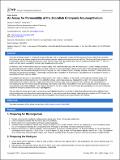An assay for permeability of the zebrafish embryonic neuroepithelium
Author(s)
Chang, Jessica T.; Sive, Hazel L.
DownloadChang-2012-An assay for permeab.pdf (282.8Kb)
PUBLISHER_POLICY
Publisher Policy
Article is made available in accordance with the publisher's policy and may be subject to US copyright law. Please refer to the publisher's site for terms of use.
Terms of use
Metadata
Show full item recordAbstract
The brain ventricular system is conserved among vertebrates and is composed of a series of interconnected cavities called brain ventricles, which form during the earliest stages of brain development and are maintained throughout the animal's life. The brain ventricular system is found in vertebrates, and the ventricles develop after neural tube formation, when the central lumen fills with cerebrospinal fluid (CSF) 1,2. CSF is a protein rich fluid that is essential for normal brain development and function3-6.
In zebrafish, brain ventricle inflation begins at approximately 18 hr post fertilization (hpf), after the neural tube is closed. Multiple processes are associated with brain ventricle formation, including formation of a neuroepithelium, tight junction formation that regulates permeability and CSF production. We showed that the Na,K-ATPase is required for brain ventricle inflation, impacting all these processes 7,8, while claudin 5a is necessary for tight junction formation 9. Additionally, we showed that "relaxation" of the embryonic neuroepithelium, via inhibition of myosin, is associated with brain ventricle inflation.
To investigate the regulation of permeability during zebrafish brain ventricle inflation, we developed a technique previously developed in our lab10, to fluorescently label the cerebrospinal fluid. Embryos are then imaged over time as the fluorescent dye moves through the brain ventricles and neuroepithelium. The distance the dye front moves away from the basal (non-luminal) side of the neuroepithelium over time is quantified and is a measure of neuroepithelial permeability (Figure 1). We observe that dyes 70 kDa and smaller will move through the neuroepithelium and can be detected outside the embryonic zebrafish brain at 24 hpf (Figure 2).
This dye retention assay can be used to analyze neuroepithelial permeability in a variety of different genetic backgrounds, at different times during development, and after environmental perturbations. It may also be useful in examining pathological accumulation of CSF. Overall, this technique allows investigators to analyze the role and regulation of permeability during development and disease.
Date issued
2012-10Department
Massachusetts Institute of Technology. Department of Biology; Whitehead Institute for Biomedical ResearchJournal
Journal of Visualized Experiments
Publisher
MyJoVE Corporation
Citation
Chang, Jessica T., and Hazel Sive. “An Assay for Permeability of the Zebrafish Embryonic Neuroepithelium.” JoVE no. 68 (2012).
Version: Final published version
ISSN
1940-087X